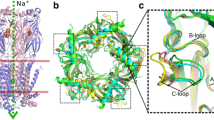Abstract
The nicotinic acetylcholine receptors (nAChRs) are members of the Cys-loop superfamily and contain ligand gated ion channels (LGIC). These receptors are located mostly in the central nervous system (CNS) and peripheral nervous system (PNS). nAChRs reside at pre-synaptic regions to mediate acetylcholine neurotransmission and in the post synaptic membrane to propagate nerve impulses through neurons via acetylcholine. Malfunction of this neurotransmitter receptor is believed to cause various neurodegenerative diseases, such as Alzheimer’s disease, Parkinson’s disease and schizophrenia, and nAChRs are thus important drug targets. In the present work, starting from an earlier model of pentameric α7nAChR, a considerable effort has been taken to investigate interaction with ligands by performing docking studies with a diverse array of agonists and antagonists. Analysis of these docking complexes reveals identification of possible ligand-interacting residues. Some of these residues, e.g. Ser34, Gln55, Ser146, and Tyr166, which are evolutionarily conserved, were specifically subjected to virtual mutations based on their amino acid properties and found to be highly sensitive in the presence of antagonists by docking. Further, the study was extended using evolutionary trace analysis, revealing conserved and class-specific residues close to the putative ligand-binding site, further supporting the results of docking experiments.











Similar content being viewed by others
References
Van Rensburg R, Chazot P (2008) Alpha7 nicotinic acetylcholine receptors: molecular pharmacology and role in neuroprotection. Curr Anaesth Crit Care 19(4):202–214. doi:10.1016/j.cacc.2008.05.001
Changeux JP, Taly A (2008) Nicotinic receptors, allosteric proteins and medicine. Trends Mol Med 14(3):93–102. doi:10.1016/j.molmed.2008.01.001
Celie PH, van Rossum-Fikkert SE, van Dijk WJ, Brejc K, Smit AB, Sixma TK (2004) Nicotine and carbamylcholine binding to nicotinic acetylcholine receptors as studied in AChBP crystal structures. Neuron 41(6):907–914. doi:10.1016/S0896-6273(04)00115-1
Brejc K, van Dijk WJ, Klaassen RV, Schuurmans M, van Der Oost J, Smit AB, Sixma TK (2001) Crystal structure of an ACh-binding protein reveals the ligand-binding domain of nicotinic receptors. Nature 411(6835):269–276. doi:10.1038/35077011
Capener CE, Kim HJ, Arinaminpathy Y, Sansom MS (2002) Ion channels: structural bioinformatics and modelling. Hum Mol Genet 11(20):2425–2433
Harel M, Kasher R, Nicolas A, Guss JM, Balass M, Fridkin M, Smit AB, Brejc K, Sixma TK, Katchalski-Katzir E, Sussman JL, Fuchs S (2001) The binding site of acetylcholine receptor as visualized in the X-Ray structure of a complex between alpha-bungarotoxin and a mimotope peptide. Neuron 32(2):265–275. doi:10.1016/S0896-6273(01)00461-5
Bourne Y, Talley TT, Hansen SB, Taylor P, Marchot P (2005) Crystal structure of a Cbtx-AChBP complex reveals essential interactions between snake alpha-neurotoxins and nicotinic receptors. EMBO J 24(8):1512–1522. doi:10.1038/sj.emboj.7600620
Dellisanti CD, Yao Y, Stroud JC, Wang ZZ, Chen L (2007) Crystal structure of the extracellular domain of nAChR alpha1 bound to alpha-bungarotoxin at 1.94 A resolution. Nat Neurosci 10(8):953–962. doi:10.1038/nn1942
Unwin N (2005) Refined structure of the nicotinic acetylcholine receptor at 4A resolution. J Mol Biol 346(4):967–989. doi:10.1016/j.jmb.2004.12.031
Karlin A (2002) Emerging structure of the nicotinic acetylcholine receptors. Nat Rev Neurosci 3(2):102–114. doi:10.1038/nrn731
Schapira M, Abagyan R, Totrov M (2002) Structural model of nicotinic acetylcholine receptor isotypes bound to acetylcholine and nicotine. BMC Struct Biol 2(1):1–8. doi:10.1186/1472-6807-2-1
Le Novère N, Grutter T, Changeux JP (2002) Models of the extracellular domain of the nicotinic receptors and of agonist- and Ca2+ -binding sites. Proc Natl Acad Sci USA 99(5):3210–3215. doi:10.1016/S0306-4522(00)00512-1
Itier V, Bertrand D (2001) Neuronal nicotinic receptors: from protein structure to function. FEBS Lett 504(3):118–125. doi:10.1016/S0014-5793(01)02702-8
Ivanov I, Cheng X, Sine SM, McCammon JA (2007) Barriers to ion translocation in cationic and anionic receptors from the Cys-loop family. J Am Chem Soc 129(26):8217–8224. doi:10.1021/ja070778l
Parthiban M, Rajasekaran MB, Ramakumar S, Shanmughavel P (2009) Molecular modeling of human pentameric alpha(7) neuronal nicotinic acetylcholine receptor and its interaction with its agonist and competitive antagonist. J Biomol Struct Dyn 26(5):535–548. doi:10.1016/j.jmgm.2008.01.004
Sali A, Blundell TL (1993) Comparative protein modelling by satisfaction of spatial restraints. J Mol Biol 234(3):779–815. doi:10.1016/S1357-4310(95)91170-7
Holm L, Park J (2000) DaliLite workbench for protein structure comparison. Bioinformatics 16(6):566–567
Morris AL, MacArthur MW, Hutchinson EG, Thornton JM (1992) Stereochemical quality of protein structure coordinates. Proteins 12(4):345–364
Kanagarajadurai K, Malini M, Bhattacharya A, Panicker M, Sowdhamini R (2009) Molecular modeling and docking studies of human 5-hydroxytryptamine 2A (5-HT2A) receptor for the identification of hotspots for ligand binding. Mol BioSyst 5:1877–1888, doi: 10.1039/b906391a
Bairoch A, Apweiler R (1997) The SWISS-PROT protein sequence data bank and its supplement TrEMBL. Nucleic Acids Res 25(1):31–36
Innis CA, Shi J, Blundell TL (2000) Evolutionary trace analysis of TGF-beta and related growth factors: implications for site-directed mutagenesis. Protein Eng 13(12):839–847
Waterhouse AM, Procter JB, Martin DM, Clamp M, Barton GJ (2009) Jalview Version 2—a multiple sequence alignment editor and analysis workbench. Bioinformatics 25(9):1189–1191
Lichtarge O, Bourne HR, Cohen FE (1996) An evolutionary trace method defines binding surfaces common to protein families. J Mol Biol 257(2):342–358. doi:10.1006/jmbi.1996.0167
Lin F, Wang R (2009) Molecular modeling of the three-dimensional structure of GLP-1R and its interactions with several agonists. J Mol Model 15(1):53–65. doi:10.1007/s00894-008-0372-2
Acknowledgements
The authors (M.P. and P.S.) thank the Department of Biotechonolgy-Bioinformatics Infrastructural Facility provided at Bharathiar University, Coimbatore. We also thank the National Centre for Biological Sciences, Bangalore, for infrastructural support.
Author information
Authors and Affiliations
Corresponding author
Rights and permissions
About this article
Cite this article
Parthiban, M., Shanmughavel, P. & Sowdhamini, R. In silico point mutation and evolutionary trace analysis applied to nicotinic acetylcholine receptors in deciphering ligand-binding surfaces. J Mol Model 16, 1651–1670 (2010). https://doi.org/10.1007/s00894-010-0670-3
Received:
Accepted:
Published:
Issue Date:
DOI: https://doi.org/10.1007/s00894-010-0670-3




